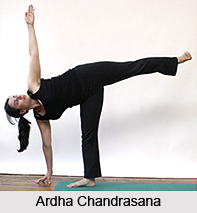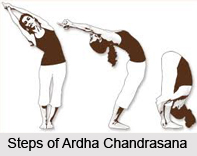 Ardha Chandrasana is a rudimentary form of the Chandrasana, and is classed a cultural asana in modern yoga parlance. It is a standing and balancing pose, strengthening the ankle and thighs, and improves overall balance of the body. The asana is therapeutically effective for anxiety, backache, osteoporosis, fatigue, constipation, gastritis, indigestion and menstrual pain.
Ardha Chandrasana is a rudimentary form of the Chandrasana, and is classed a cultural asana in modern yoga parlance. It is a standing and balancing pose, strengthening the ankle and thighs, and improves overall balance of the body. The asana is therapeutically effective for anxiety, backache, osteoporosis, fatigue, constipation, gastritis, indigestion and menstrual pain.
Yoga Texts and Archa Chandrasana
The Chandrasana is a fairly prominent Yoga Asana, described in the Hatha Yoga Pradipika, (1400 AD) and in later asana manuals. The Archa Chandrasana described in the Shri Tattva Nidhi however, is equivalent to the modern Vrksasana, indicating that the nature of the pose may have been in flux until it was fixed in its current version in contemporary yoga practice.
Practice of Ardha Chandrasana:
* Start with Trikonasana.
* Soften the right knee and bring the left hand to the hip.
* Bring the right hand to the floor about a foot in front of the right foot with the fingertips on the floor.
* Begin to straighten the right leg while simultaneously kicking up the left leg.
* Open the hips, stacking the left hip on top of the right hip.
 * Bring the left leg straight and parallel to the floor, flexing the left foot with the toes facing forward.
* Bring the left leg straight and parallel to the floor, flexing the left foot with the toes facing forward.
* When feeling balanced on the right leg, reach the left arm up towards the ceiling, opening the chest and making a straight line with the right and left arms.
* Finally, bring the gaze up towards the left fingertips.
* Repeat on the left side.
Take a block underneath the right hand. Do the pose near a wall and bring the left foot to the wall when kicking up the left leg. Bring the right hand a few inches off of the floor.
Effects of Ardha Chandrasana
* Strengthens the abdomen, ankles, thighs, buttocks and spine.
* Stretches the groins, hamstrings and calves, shoulders, chest and spine.
* Improves coordination and sense of balance.
* Helps relieve stress.
* Improves digestion.
Precautions in the practice of Ardha Chandrasana
If there are any neck problems, do not turn the head to look upward; continue looking straight ahead and keep both sides of the neck evenly long.
* Headache or migraine
* Low blood pressure
* Diarrhea
* Insomnia




















